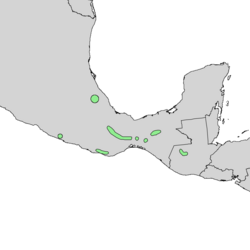| Pinus chiapensis | |
|---|---|
 | |
| Scientific classification | |
| Kingdom: | Plantae |
| Clade: | Tracheophytes |
| Clade: | Gymnospermae |
| Division: | Pinophyta |
| Class: | Pinopsida |
| Order: | Pinales |
| Family: | Pinaceae |
| Genus: | Pinus |
| Subgenus: | P. subg. Strobus |
| Section: | P. sect. Quinquefoliae |
| Subsection: | P. subsect. Strobus |
| Species: | P. chiapensis |
| Binomial name | |
| Pinus chiapensis | |
 | |
| Natural range of Pinus chiapensis | |
| Synonyms | |
Pinus strobus var. chiapensis | |
Pinus chiapensis is a pine tree species in the family Pinaceae, and is commonly known as Chiapas pine, in Spanish as pino blanco, pinabete, or ocote. [1] Chiapas pine was formerly considered to be a variant of Pinus strobus , but is now understood to be a separate species. [2]
